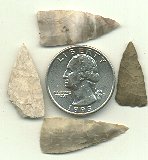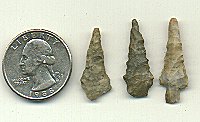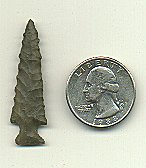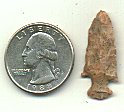SMALL POINTS
![]()
![]()

These are called Edwards points, known for their flaring basal ears

Below is a Washita point, its a very nice one that I found while the lake was down.

These are called Keota points (very common) they are a small thin triangular side to corner notched point with a rounded base. Check out the teeny tiny one, don't know how I ever saw that little thing.

The pic below
shows some of the most common type of arrow points you find, triangle points, some people call them "war points". A few of these are extremely thin, and have very sharp tips. You most likely will find many of these if your in an area that held alot of the mississippian dwellers.

The picture below is of a dardanelle point, it is from the mississipian period 600-400 yrs before present. It is commonly associated with the caddo people. This type was found in bundles of caches in the spiro mound site in oklahoma. It was found on lake hudson, mayes co. oklahoma on 6-3-87 by me.

Below is a pic of two washita points, mississippian 800-400 b.p. The washita is close in form to the harrel type of point, but the harrel has a notch in the center of the base. These were found #1 3-26-87 and #2 8-14-89, on hudson lake.
Below are some sequoyah
points. Mississippian 1000-600 b.p. They are known for their long,
usually serrated points, and a bulbous stem. These are extremely common, as are the keota and scallorn points around here. Found
#1 6-12-89, #2 5-21-89 and #3 8-22-91.
Below, some merom points. Late archaic-woodland 4000-2000 b.p. They are known for
their wide corner notch's. Found #1 6-3-87 and #2 4-16-91.
The keota points below, being one of the more common points found, dates from the mississippian era 800-600 b.p. Found #1 4-24-88 and #2 4-4-90 
This destinct wicked little point is called a ft. ancient. Mississipian-historic
800-400 b.p. Look at the fine even serrations. If you got in the way of it, it would inflict quite some damage. I found it almost in a
friend of mines footsteps. I showed it to him before I picked it up, he wasn't a happy camper. 7-2-94. 
The scallorn is a popular "bird point" from woodland to mississippian periods 1300-500 b.p. Some are finely serrated, as seen in this collection. 
This ensor point was spotted by me and a good friend of
mine at almost the same time, i had to wrestle him for it. All that wrestling around with my brothers paid off. Note the oblique flaking on it, and the nice serrations. Dating from the late archaic-early woodland 4000-1500 b.p. Found 7-22-91.
This point below is a "classic" keota. It really is
a pretty point, but you cant tell from the picture. It's thin
a has good pressure flaking.

And this one is a "classic" sequoyah. When i say classic, i mean it has all the features that are known to make it that type exactly, that there is no doubt. This one is sequoyah all the way, from the long tip, to the small bulbous stem.